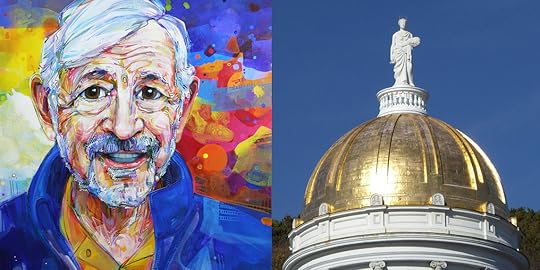Doc Searls's Blog, page 16
February 28, 2025
Blogging like it’s 1999
 The header of my blog from 1999 to 2007
The header of my blog from 1999 to 2007Testing Wordland, about which Dave says more here.
This is my second blog, and my first WordPress one. It launched in 2007. My first blog is this one, which (courtesy of Dave) started in the last year of the prior millennium. I had hair then, and wore glasses.
Is this true? I want more sources.
Irony of wanting more sources: there is already too much information. Examples: this window has 30 tabs, in a browser with four windows, each with more tabs than I’ll bother to count. I also have four other open browsers. Trying to stay on top of all this stuff is like standing on a ball. So I save a lot of tabs: 10716 with OneTab. So far.
The Knicks are better than they look to this guy. Even if the Celtics and the Cavs are better overall. The playoffs will be fun. Between now and then, the Celtics City series looks like it will probably be good too. (Never mind what teams you hate. I’ve always hated the Lakers and the Yankees, but have no trouble watching documentaries on them. Villains—even ones that aren’t really—are always interesting.
All new comments to old blog posts are suspicious.
I just gave this post a category. It’s from my WordPress roster. Nice. Curious now about how to include images.
Will our agents increase our agency?
Stowe Boyd on economic uncertainty. About a year ago I had a dream that three things would happen, though I wasn’t sure in what order (or if they would at all, being a dream). One was that the Celtics would win the NBA championship. Another was that Trump would win the presidential election. And one was that the economy would crash. So far, so two.
Some numbers. The U.S. has 4% of the world’s population and,
—consumes ~17% of its energy, and around
—20% of its oil (most in the world)
—21% of its natural gas (also most)
—8% of its coal (declining but still)
—16% of its electricity
—12% of its water
—15% of its food
—30% of its consumer goods (also tops in the world)
—25% of its raw materials
—and produces 14% of the world’s carbon emissions, second only to China’s.
This is from ChatGPT, so redraw your own conclusions. My provisional one is that an adjustment is bound to happen.
Dave kindly notes that I’ve been an early user of his writing tools for the Web. I should add that I was an early wannabe user of Think Tank (after I met Dave and his brother at their booth at Comdex in Atlanta in 1984… but I didn’t have a computer to run it on) and MORE, which was the best writing tool of any kind that I have ever used. Such a killer app. Wish it had been at the top of the food chain. (But its ghost lives on in the tools Dave has been making since then.)
February 23, 2025
Lifting the Lid on Government Meetings
Twenty-sixth in the News Commons series.
On the left is Tom Evslin, former CTO for Vermont. On the right is the golden dome atop Vermont’s capitol building. Underneath that dome, and in countless spaces in government bodies everywhere are meetings recorded in video. Reviewing or reporting on those meetings is a chore. Unless that is, you use Smart Transcripts—an invention by Tom that shortens the work of reviewing a meeting by using its transcript to navigate its video. It’s open source, working in Vermont, and ready for anyone to use anywhere.
This Wednesday at Noon (Eastern time) Tom will explain where this invention came from and how it works in a talk titled Lifting the Lid on the Golden Dome: How SmartTranscripts open legislative sessions to everyone in Vermont—or anywhere. This is the latest in our Beyond the Web salon series for the Ostrom Workshop and the Hamilton Lugar School of Global and International Studies at Indiana University:
If you care about journalism, how government works, and improving our civic institutions, this will be a highly leveraged hour for you.
Register here to attend. It’s free and on Zoom.
See you there.
February 17, 2025
Maybe I need re-writer’s block
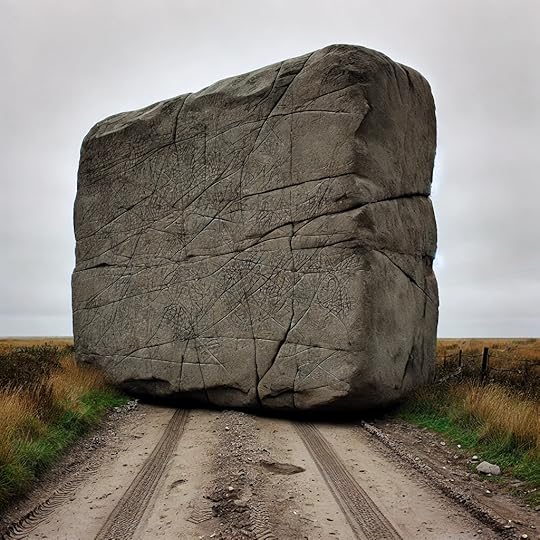
I’ve never had writer’s block. Give me a writing assignment and I’ll blab something out. It might even be good, or at least good enough. But I don’t write in final draft. Or talk that way. I know people who can do either or both. But I don’t know how they do it, much as I don’t know how somebody knows how to play a trombone. I do know that I want to take at least one “know” out of the last sentence and perhaps both of them out of this sentence as well. And hell, I want to rewrite this whole paragraph because I hate it.
I’m only sharing this small confession because I have about five essay-sized posts backed up in the queue here, and they’re all being re-written. Maybe the wait will be worth it. I dunno, so I think I’ll go eat something.
By the way, the image above is ChatGPT’s second whack at giving me an image of a writer’s block. You’re welcome.
February 12, 2025
It’s still adtech
This morning Wired published This Ad-Tech Company Is Powering Surveillance of US Military Personnel. It’s a good piece, which is typical of Wired lately. But what caught my eye was “Ad-Tech” in the headline. Some writers say “ad tech.” Others say “adtech” or “AdTech.”
I’m highly leveraged in “adtech,” since I’ve now posted 160 pieces (including this one) using that expression since 2008.
So I did a Google Trends search on the three uses, and saw that “adtech” still wins, by a hair, though “ad tech” is close, and was ahead for much of the ‘teens.
The more interesting thing is that interest in the topic itself dropped by 75% between 2004 and th e mid-teens, and has kinda flattened since then.
But it’s still an issue.
At least I am relieved of the need to go back and change all those posts.
Don’t Buy This
 Looks right, works wrong.
Looks right, works wrong.Every so often a product shows up that is so bad somebody needs to sound a warning.
So I’m sounding one for the Ion Retro Glow. For the last month or so, it’s been on display and selling at the Sams Club here in Bloomington, Indiana. That’s where I shot the photo above.
At first I thought it was just an interesting goof: an old-fashioned boom box with Bluetooth and a rechargeable battery. But then I remembered that I have about a hundred cassette tapes I want to go through, and no way to play them. I also thought the thing wouldn’t be a bad Bluetooth speaker system for my phone. The sound, while not great, wasn’t bad when I pressed the buttons on the display. I also still listen to some radio, so I thought that might be a nice bonus, if the radio was at least okay. And the price was right: $69.
So I bought one.
OMG. Quelle merde.
First, all the buttons and knobs are crap plastic, and the Stop/Eject button wouldn’t open the cassette door, making that function useless. Right there I needed to take it back. But to exchange it?
Not after checking out the radio.
The dial knob was so stiff I thought something was surely wrong with it. And there was. The dial pointer leaned one way or the other as one tuned up and down. And the radio was so bad on both bands that it would be a total turn-off to anyone wanting to give radio a try for the first time. (And there are now large demographics in that category.) Noise rejection on AM was completely absent, and the radio only got one station. There wasn’t even a tiny hint that there might be other signals out there. (And there are many here.) On FM, strong local signals splattered all over the dial, and the tuner made strange pulsing sounds as I (with lots of torque) turned the dial pointer slowly (there was no other way) up and down. And the sound kinda sucked too.
The only thing that worked as advertised was the Bluetooth. My phone found the thing instantly.
As for the sound, I’m much better served by the Bluetooth speakers I already have. There are good ones in the same price range.
The glowing rings around the speakers are just eye candy.
I suppose the rechargeable battery is okay. It worked for the few minutes I bothered checking it out.
The lesson: If you want a good boom box, check out your neighborhood or online thrift stores. Here’s Facebook Marketplace for my region here.

I suspect at least one of these is still good.
A final word to Sam’s Club: please stop selling this piece of crap. It makes victims of your customers.
February 10, 2025
On Regrets and Their Absence

Somebody just gave the 31st upvote to my answer to the Quora question “What do you regret as you get older?” So I thought it might be worth repeating.
Here’s a short list:
Not learning at least one other language.Not learning a musical instrument (or to sing) well enough to play in a group.Not getting fit physically and staying that way. (Related: not working hard to succeed in at least one varsity sport—especially one requiring teamwork.)Not spending more time in other countries and cultures when I was young.Getting married too early and often. (Since you’re asking, twice before a great marriage now going on 27 years.)For a full perspective on those, here’s a list of things I don’t regret:
Staying curious about everything, all my life. (“Learn as if you’ll live forever, live as if you’ll die tomorrow,” Gandhi is said to have said.)Learning to ski (in my 40s) and at learning to play soccer and basketball well enough not to be chosen last in pickup games.Sucking in school, which forced me to learn in other ways—and to learn well enough to at least play a decent academic later in life.Never taking up smoking, drugs or drinking heavily.Watching so little TV that I miss most cultural references to various stars and shows.There are many more possibilities for both lists, but that’s a start.
That was seven years ago. My wife and I have now been married for almost 34 years.
February 9, 2025
Fire and Rain
Twenty-fifth in the News Commons series
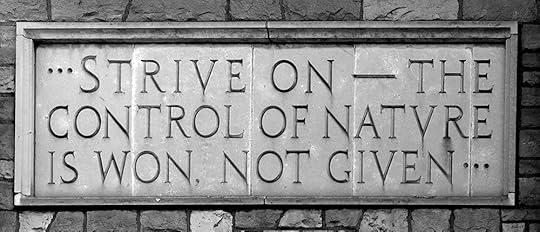 This is etched in limestone over an entrance to a building at the University of Wyoming. It gave John McPhee the title for perhaps its most useful book.
This is etched in limestone over an entrance to a building at the University of Wyoming. It gave John McPhee the title for perhaps its most useful book.Southern California has two seasons: Fire and Rain.
Rain didn’t begin this year until a few days after Fire ended apocalyptically, incinerating much of Altadena and Pacific Palisades. Now Rain is here, with the occasional atmospheric river flowing across the faces of hills and mountains whose beards were just burned off.
Much has been written about what geologists call debris flows. These tend to happen when mountains of poorly bound slopes of loose rock and soil get drenched in rain after the vegetation holding everything in place has been burned away. Many of these slopes are like mile-wide dump trucks waiting to hoist their beds and open their tailgates. The towns know about this, and are ready with debris basins and other risk abatements. But so are the mountains, which are much bigger, and similar to volcanoes in their tectonic youth and tendency to slide down and outward almost as fast as they go up.
For describing all this, no writing is more useful than John McPhee‘s Los Angeles Against The Mountains, which ran first as long essays in September and October 1988 editions of The New Yorker, and later as a chapter in The Control of Nature, which came out in 1990. (Another chapter in that book is “The Army Corps of Engineers vs. the Mississippi,” which first appeared as Achafalya in a 1987 issue of The New Yorker. The magazine ran it again after Hurricane Katrina as if it were a live report on what happened when the levees failed in New Orleans—though it had been written, prophetically, seventeen years earlier.)
McPhee is the Beethoven, the Rembrandt, the Shakespeare of nonfiction: inimitable and without equal. At ninety-three he is still writing and teaching other writers at Princeton. Though I’ve never set foot in Princeton, McPhee has been teaching me how to write for many decades. I have read all his books, some many times. A few have so many page flags I could brush off a table with them. Some of those flags now aid my compression of “Los Angeles Against the Mountains.”
Here he frames the battle:
…in the confrontation of the urban and the wild. Los Angeles is overmatched on one side by the Pacific Ocean and on the other by very high mountains. With respect to these principal boundaries, Los Angeles is done sprawling. The San Gabriels, in their state of tectonic youth, are rising as rapidly as any range on earth. Their loose inimical slopes flout the tolerance of the angle of repose. Rising straight up out of the megalopolis, they stand ten thousand feet above the nearby sea, and they are not kidding with this city. Shedding, spalling, self-destructing, they are disintegrating at a rate that is also among the fastest in the world…
The slopes average sixty-five to seventy per cent. In numerous places, they are vertical…The term “oversteepened” is often used to describe them. At the giddy extreme of oversteepening is the angle of maximum slope. Very large sections of the San Gabriels closely approach that angle. In such terrain, there is not much to hold the loose material except the plants that grow there…
And here he’s describing the experience of hanging with geologists on the steep face of one slope:
Evergreen oaks were fingering up the creases in the mountainsides, pointing toward the ridgeline forests of big-cone Douglas fir, of knobcone and Coulter pine. The forests had an odd sort of timberline. They went down to it rather than up. Down from the ridges the conifers descended through nine thousand, seven thousand, six thousand feet, stopping roughly at five. The forests abruptly ended—the country below being too dry in summer to sustain tall trees. On down the slopes and all the way to the canyons was a thicket of varied shrubs that changed in character as altitude fell but was everywhere dense enough to stop an army. On its lower levels, it was all green, white, and yellow with buckwheat, burroweed, lotus and sage, deerweed, bindweed, yerba santa… The thicket’s resistance to trespass, while everywhere formidable, stiffened considerably as it evolved upward…Whatever and wherever they were, these plants were prickly, thick, and dry, and a good deal tougher than tundra. Those evergreen oaks fingering up the creases in the mountains were known to the Spaniards as chaparros. Riders who worked in the related landscape wore leather overalls open at the back, and called them chaparajos. By extension, this all but impenetrable brush was known as chaparral.
The low stuff, at the buckwheat level, is often called soft chaparral. Up in the tough chamise, closer to the lofty timber, is high chaparral, which is also called hard chaparral. High or low—hard, soft, or mixed—all chaparral has in common an always developing, relentlessly intensifying, vital necessity to burst into flame. In a sense, chaparral consumes fire no less than fire consumes chaparral. Fire nourishes and rejuvenates the plants. There are seeds that fall into the soil, stay there indefinitely, and will not germinate except in the aftermath of fire. There are basal buds that sprout only after fire. Droughts are so long, rains so brief, that dead bits of wood and leaves scarcely decay. Instead, they accumulate, thicken, until the plant community is all but strangling in its own duff. The nutrients in the dead material are being withheld from the soil. When fire comes, it puts the nutrients back in the ground. It clears the terrain for fresh growth. When chaparral has not been burned for thirty years, about half the thicket will be dry dead stuff—twenty-five thousand tons of it in one square mile. The living plants are no less flammable. The chamise, the manzanita—in fact, most chaparral plants—are full of solvent extractives that burn intensely and ignite easily. Their leaves are glossy with oils and resins that seal in moisture during hot dry periods and serve the dual purpose of responding explosively to flame. In the long dry season, and particularly in the fall, air flows southwest toward Los Angeles from the Colorado Plateau and the Basin and Range. Extremely low in moisture, it comes out of the canyon lands and crosses the Mojave Desert. As it drops in altitude, it compresses, becoming even dryer and hotter. It advances in gusts. This is the wind that is sometimes called the foehn. The fire wind. The devil wind. In Los Angeles, it is known as Santa Ana. When chamise and other chaparral plants sense the presence of Santa Ana winds, their level of moisture drops, and they become even more flammable than they were before. The Santa Anas bring what has been described as “instant critical fire weather.” Temperatures rise above a hundred degrees. Humidity drops very close to zero. According to Charles Colver, of the United States Forest Service, “moisture evaporates off your eyeballs so fast you have to keep blinking.”
About fires, when they happen, he says this:
…Where the Santa Anas collide with local mountain winds, they become so erratic that they can scatter a fire in big flying brands for a long distance in any direction. The frequency and the intensity of the forest fires in the Southern California chaparral are the greatest in the United States, with the possible exception of the wildfires of the New Jersey Pine Barrens.
McPhee’s writing is always wrapped around characters, most of which I’m leaving out of this compression. The first exception for our purpose here is Wade Wells, a hydrologist with the United States Forest Service.
The chaparral fires are considerably more potent than the forest fires Wade Wells saw when he was an undergraduate at the University of Idaho or when he worked as a firefighter in the Pacific Northwest. “Fires in the Pacific Northwest are nothing compared with these chaparral fires,” he remarked. “Chaparral fires are almost vicious by comparison. They’re so intense. Chaparral is one of the most flammable vegetation complexes there are.”
It burns as if it were soaked with gasoline. Chaparral plants typically have multiple stems emerging from a single root crown, and this contributes not only to the density of the thickets but, ultimately, to the surface area of combustible material that stands prepared for flame. Hundreds of acres can be burned clean in minutes. In thick black smoke there is wild orange flame, rising through the canyons like explosion crowns. The canyons serve as chimneys, and in minutes whole mountains are aflame, resembling volcanoes, emitting high columns of fire and smoke…
In millennia before Los Angeles settled its plain, the chaparral burned every thirty years or so, as the chaparral does now. The burns of prehistory, in their natural mosaic, were smaller than the ones today. With cleared fire lanes, chemical retardants, and other means of suppressing what is not beyond control, people have conserved fuel in large acreages. When the inevitable fires come, they burn hotter, higher, faster than they ever did in a state of unhindered nature. When the fires end, there is nothing much left on the mountainsides but a thin blanket of ash. The burns are vast and bare. On the sheer declivities where the surface soils were held by chaparral, there is no chaparral.
Fine material tumbles downslope and collects in the waterless beds of streams. It forms large and bulky cones there, to some extent filling the canyons. Under green chaparral, the gravitational movement of bits of soil, particles of sand, and other loose debris goes on month after month, year after year, especially in oversteepened environments, where it can represent more than half of all erosion. After a burn, though, it increases exponentially. It may increase twentyfold, fortyfold, even sixtyfold. This steady tumbling descent of unconsolidated mountain crumbs is known as dry ravel. After a burn, so much dry ravel and other debris becomes piled up and ready to go that to live under one of those canyons is (as many have said) to look up the barrel of a gun.
One would imagine that the first rain would set the whole thing off, but it doesn’t. The early-winter rains—and sometimes the rains of a whole season—are not enough to make the great bulk move. Actually, they add to it…
In the slow progression of normal decay, chaparral litter seems to give up to the soil what have been vaguely described as “waxlike complexes of long-chain aliphatic hydrocarbons.” These waxy substances are what make unburned chaparral soil somewhat resistant to water, or “slightly nonwettable,” as Wells and his colleagues are wont to describe it. When the wildfires burn, and temperatures at the surface of the ground are six or seven hundred centigrade degrees, the soil is so effective as an insulator that the temperature one centimetre below the surface may not be hot enough to boil water. The heavy waxlike substances vaporize at the surface and recondense in the cooler temperatures below. Acting like oil, they coat soil particles and establish the hydrophobic layer—one to six centimetres down. Above that layer, where the waxlike substances are gone, the veneer of burned soil is “wettable.” When Wells drips water on a dishful of that, the water soaks in as if the dish were full of Kleenex. When rain falls on burned and denuded ground, it soaks the very thin upper layer but can penetrate no farther. Hiking boots strike hard enough to break through into the dust, but the rain is repelled and goes down the slope. Of all the assembling factors that eventually send debris flows rumbling down the canyons, none is more detonative than the waterproof soil.
In the first rains after a fire, water quickly saturates the thin permeable layer, and liquefied soil drips downhill like runs of excess paint. These miniature debris flows stripe the mountainsides with miniature streambeds—countless scarlike rills that are soon the predominant characteristic of the burned terrain. As more rain comes, each rill is going to deliver a little more debris to the accumulating load in the canyon below. But, more to the point, each rill—its natural levees framing its impermeable bed—will increase the speed of the surface water. As rain sheds off a mountainside like water off a tin roof, the rill network, as it is called, may actually cube the speed, and therefore the power, of the runoff. The transport capacity of the watershed—how much bulk it can move—may increase a thousandfold. The rill network is prepared to deliver water with enough force and volume to mobilize the deposits lying in the canyons below. With the appearance of the rills, almost all prerequisites have now sequentially occurred. The muzzle-loader is charged. For a full-scale flat-out debris flow to burst forth from the mountains, the final requirement is a special-intensity storm.
Some of the most concentrated rainfall in the history of the United States has occurred in the San Gabriel Mountains. The oddity of this is about as intense as the rain. Months—seasons—go by in Los Angeles without a fallen drop. Los Angeles is one of the least-rained-upon places in the Western Hemisphere. The mountains are so dry they hum. Erosion by dry ravel greatly exceeds erosion by water. The celebrated Mediterranean climate of Los Angeles owes itself to aridity. While Seattle is receiving its average rainfall of thirty-nine inches a year, Chicago thirty-three, the District of Columbia thirty-nine, and New York City forty-four, Los Angeles is doing well if it gets fifteen. In one year out of every four over the past century, rainfall in Los Angeles has been under ten inches, and once or twice it was around five. That is pure Gobi. When certain storm systems approach Los Angeles, though—storms that come in on a very long reach from far out in the Pacific—they will pick up huge quantities of water from the ocean and just pump it into the mountains…
Here begins a story about one debris flow, in a setting high and dry:
Five miles into the mountains from the edge of the city is a small, obscure, steep-sided watershed of twenty-five hundred acres which is drained by the Middle Fork of Mill Creek, a tributary of the Big Tujunga. The place is so still you can hear the dry ravel…
Then came Fire:
It was a textbook situation—a bowl in the mountains filled with hard chaparral that had not been touched by fire in ninety-nine years. The older chaparral becomes, the hotter it burns. In its first ten years of new growth, it is all but incombustible. After twenty years, its renewed flammability curves sharply upward. It burns, usually, before it is forty years old. The hotter the fire, the more likely a debris flow—and the greater the volume when it comes. The century-old fuel of the Middle Fork was so combustible that afterward there were not even stumps. The slopes looked sandpapered. The streambed, already loaded, piled even higher with dry ravel. The Middle Fire, as the burn was known, was cause for particular alarm, because a small settlement was a mile downstream. Its name—Hidden Springs—contained more prophecy than its residents seemed prepared to imagine. Three hundred and ninety thousand cubic yards of loose debris was gathered just above them, awaiting mobilization.
Then, Rain:
Toward midnight February 9th, an accidental fire broke out in a small building of Gabe Hinterberg’s. A fire truck eventually came. Half a dozen people fought the fire, assisted by the heavy rain. One of them was George Scribner. The five-minute spike of greatest downpour occurred at about one-thirty. Half an hour later, George said, “Hey, we got the fire put out.”
Gabe said, “Good deal.”
And then Gabe and George were dead.
Amos Lewis, nearby, was holding a fire hose in his hand and was attempting to prevent it from kinking. In his concentration, he did not see danger coming. He heard nothing ominous. He only felt the hose draw taut. Through his peripheral vision he became aware that the fire truck—with the hose connected to it—was somehow moving sideways. Seconds later, Amos Lewis, too, was swept away.
The snout of the debris flow was twenty feet high, tapering behind. Debris flows sometimes ooze along, and sometimes move as fast as the fastest river rapids. The huge dark snout was moving nearly five hundred feet a minute and the rest of the flow behind was coming twice as fast, making roll waves as it piled forward against itself—this great slug, as geologists would describe it, this discrete slug, this heaving violence of wet cement. Already included in the debris were propane tanks, outbuildings, picnic tables, canyon live oaks, alders, sycamores, cottonwoods, a Lincoln Continental, an Oldsmobile, and countless boulders five feet thick. All this was spread wide a couple of hundred feet, and as the debris flow went through Hidden Springs it tore out more trees, picked up house trailers and more cars and more boulders, and knocked Gabe Hinterberg’s lodge completely off its foundation. Mary and Cal Drake were standing in their living room when a wall came off. “We got outside somehow,” he said later. “I just got away. She was trying to follow me. Evidently, her feet slipped out from under her. She slid right down into the main channel.” The family next door were picked up and pushed against their own ceiling. Two were carried away. Whole houses were torn loose with people inside them. A house was ripped in half. A bridge was obliterated. A large part of town was carried a mile downstream and buried in the reservoir behind Big Tujunga Dam. Thirteen people were part of the debris. Most of the bodies were never found.
As Amos Lewis suddenly found himself struggling in the viscous flow, he more or less bumped into a whirling pickup, coming down in the debris from who knows where upstream. One of the roll waves picked him up and threw him into the back of the truck. As the vehicle spun around and around, it neared one bank. Lewis saw an overhanging limb. He reached for it, caught it, and pulled himself above the rocky flow. Years later, just about where this had happened, he told Wade Wells and me the story. “I got pushed to one side,” he said as he finished. “I lucked out.” Lewis is a prematurely white-haired man with a white beard and dark-brown eyes. On this day in late spring, his muscular build and deeply tanned skin were amply displayed by a general absence of clothing. He wore bluejean shorts, white socks, mountain boots, and nothing else. When people began to discover human remains in the reservoir, he had gone in his patrol car to investigate the fate of his neighbors. “I had to go roll on them calls,” he said. “A deputy sheriff has to roll on any type of body being found. I carried out at least four, maybe five, skulls.”
These are all things to bear in mind when we visit how news ought to work in a digital environment where facts mostly don’t matter—until they do.
February 6, 2025
What Makes an AI personal?
 Prompt to ChatGPT: “Give me an image of a personal AI: one belonging to the individual and in control of the individual”
Prompt to ChatGPT: “Give me an image of a personal AI: one belonging to the individual and in control of the individual”The unintended risks of handing over our lives to Personal AI is the headline of the opening segment of Jamie Smith‘s newsletter today. In it he shares a post by Liz Gerber about an autonomous choice made by the AI in her self-parking car:
Last night, my car automatically parked in the grocery store parking lot. The car beautifully maneuvered itself into a parking spot avoiding colliding with other cars and people walking through the lot.
However the car prioritized performance, fine tuning its movement in the parking spot as my fellow shoppers waited in below freezing temperatures for the car to do a perfect job.
The car failed to register that one shopper was a mom with a crying child in her arms and a toddler tugging at her leg. And it failed to take into account the several cars that were waiting to turn into the parking lot, causing a backup on the street.
While the experience was delightful for me, the car was inconsiderate of others. Even worse, I didn’t notice the others until after the car had parked itself.
I didn’t stop my car from prioritizing my needs over others. I not only handed over steering to my car, I handed over my humanity.
Jamie then asks, What happens when we hand over our experiences – often very human experiences – to an AI agent? and added in summary, Digital wallets and Personal AI are going to have a transformative effect on our lives and society. But let’s make sure we don’t hand over our humanity with it.
Here’s another question: Is the AI in Liz’s car personal?
If we want truly personal AI—the kind under our control, working for us, enlarging our agency in the world—the answer to that question has to be no.
The AI in Liz’s car is not hers. It belongs to the car’s maker. It does not contain or express her humanity or extend her agency. It may be personalized, but it is not personal. (About the difference.)
We don’t have personal AI yet. Yes, there is plentiful personalized AI, but nothing as personal as your pants, your PC, or the car you operate entirely on your own. Nothing that makes you more independent, not less.
We’re working at Kwaai on an open-source personal AI operating system (pAI-OS). There are other projects as well. But we don’t yet have a personal AI that does all the things this image suggests—
—much less an AI of our own that can express our ethical preferences.
Meanwhile, we need to be careful not to call the AIs in our things (especially big dangerous ones, such as cars) personal. They are not.
Personal AI is a greenfield. And there is a risk nothing will grow in it if we keep calling stuff like a car’s autonomous parking “personal AI.”
February 3, 2025
A Hat Tip to United
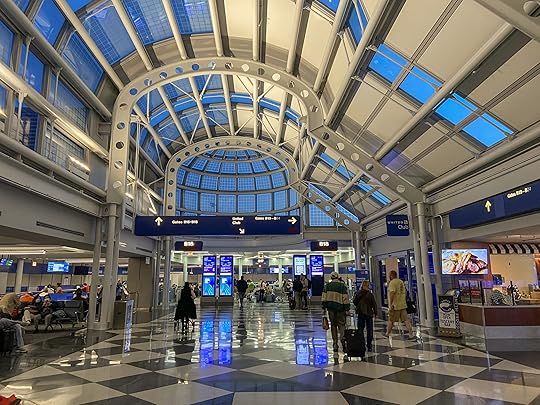 The location of just one United Club at O’Hare (ORD), one of United’s main hubs, through which I have transited countless times.
The location of just one United Club at O’Hare (ORD), one of United’s main hubs, through which I have transited countless times.United Airlines details 6 big inflight entertainment updates, including all-new Control Tower map, by Zach Griff in The Points Guy, is thick with welcome news for frequent United fliers, of which my wife and I are two. (So far I have clocked 1,533,214 miles with United, and she has about double that. We are also both lifetime members of the United Club, thanks to her wise investment in a sweet deal offered by United decades ago—and withdrawn quickly after that.)
We are also both T-Mobile customers, which is why seeing this on my phone’s United app is always welcome:

It mostly works. Yes, it’s slow, but it is possible to get work done at altitude at no extra cost. Very nice.
Here’s the rundown of new stuff from United, according to Zach:
New 4K seatback screens“Bluetooth connectivity at every seat, making it possible to pair wireless headphones, including AirPods, with the entertainment systems.”Control Tower View: “This view allows you to pull up a map of the airfield that’s overlaid with all the aircraft around you. Clicking on each little plane brings up its call sign and operating airline… powered by the flight deck’s navigation systems and a live feed of planes from FlightAware.”Starlink is coming. This will be a huge boost in bandwidth for passengers connecting to the Net on flights.Channel 9 (now called “From the Flight Deck”) is still there.Here is what that last item looked like, the last time I saw the option and shot it on a plane:

Two problems with this. First, it’s buried deep among entertainment options (Zach says it’s under the Audio tab). Second, most, if not all, pilots don’t bother with it. Back in the primitive Channel 9 days, more than half of United pilots turned it on (or left it on, if it was there by default). Or at least that was my experience. Zach:
That said, in recent years, United’s aviation enthusiast customers have complained that Channel 9 hasn’t been working. According to Green, the functionality is still very much available — it’s just that more and more pilots are choosing not to enable the feed.
“Pilots can turn it off if they don’t want people to hear whatever chatter is going on,” Green explained. All hope isn’t lost, though. “We know it’s a cool feature,” Green added. “We have it enabled as much as we can.” (That’s Dominic Green, United’s director of inflight entertainment.)
I suggest that United urge their pilots a bit more forcefully to turn the feature on. Fellow pilots and aviation buffs love having it there. And people afraid of flying also find it comforting to hear pilots sounding totally calm while flying through turbulence.
One more thing. While it would be nice to screen-share the seat-back screen from your own device, there’s this:
Extended displays aren’t coming soon
As more travelers bring their own tablets and laptops on board, I’ve always wondered why airlines don’t offer a screencasting feature on the entertainment screens. After all, it’s a lot easier to get work done with some additional screen real estate.
Turns out, United can already technically enable screencasting today, Green said, but a major issue will likely mean that flyers will never see this functionality.
“We’ve had a lot of pushback from our corporate partners that say they don’t necessarily want their staff using publicly available screens,” Green said.
It’s not that United would have access to any data; it’s that they don’t want nosy passengers snooping in on their neighbors.
Makes sense. But I think United could partner with Apple and Google to create Apple PlanePlay and Google Plane (or whatever names they want to come up with), so at least some personal apps could extend onto the seatback.
Anyway, progress.
January 25, 2025
What Works After a Disaster Happens?
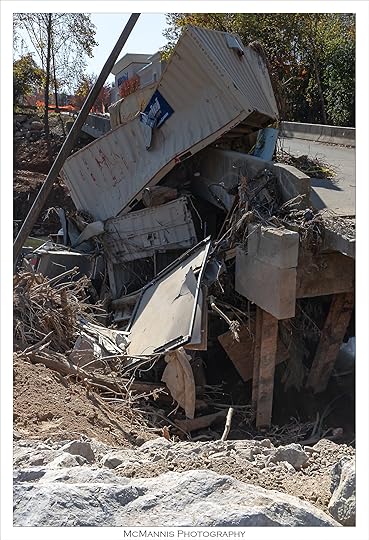 When Hurricane Helene hit Western North Carolina, the Swannanoa River rose three storys above its shores, all but erasing the town named after the river, and leaving hundreds homeless.
When Hurricane Helene hit Western North Carolina, the Swannanoa River rose three storys above its shores, all but erasing the town named after the river, and leaving hundreds homeless.But the challenge for Swannanoa was not just recovery. It was regeneration. For that, Swannanoa’s residents formed new kinds of partnerships and problem solutions that could prove a model of what to do after disasters hit communities anywhere—such as Altadena and Pacific Palisades, on which I’ve been reporting lately in my News Commons series.
Kevin Jones, one of the founders of SOCAP and curator of Nei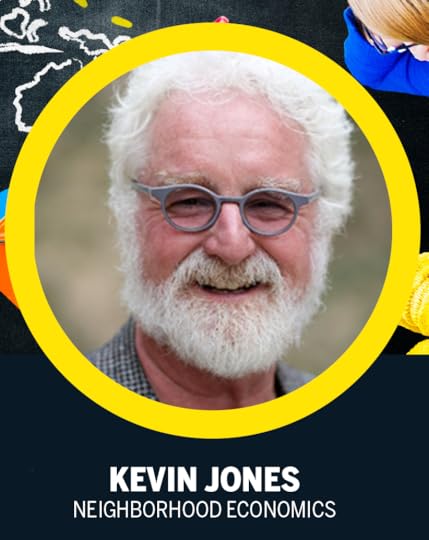 ghborhood Economics, is a Swannanoa resident reporting on what is working in real time. This next Wednesday, January 29 at Noon EST, Kevin will be doing exactly that in our Salon Series at Indiana University—and live on the Web.
ghborhood Economics, is a Swannanoa resident reporting on what is working in real time. This next Wednesday, January 29 at Noon EST, Kevin will be doing exactly that in our Salon Series at Indiana University—and live on the Web.
If you care about recovery and regeneration for your neighborhood—or anybody’s—after disaster strikes, this is a one-hour required course. As a salon, it is participatory. Come with questions, answers, or helpful stories of your own. Let’s teach and learn together, for the sake of a world larger than each of our own.
Go here for more information and the Zoom link for the salon.
Doc Searls's Blog
- Doc Searls's profile
- 11 followers


